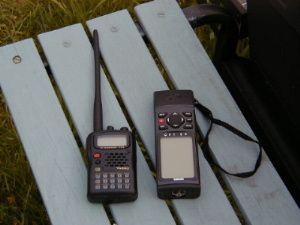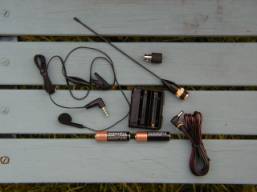<!doctype html
public "-//w3c//dtd html 4.0 transitional//en">Ultimate Hand Held Radio for Survival
By: Nietzschean
I am going to assume anyone reading this has a basic knowledge of radio communications. I would direct anyone not sure of the terms I use or other specifics of radio technology to check with their team engineer/technician, or search the American Radio Relay League website at www.arrl.net. There is a wealth of information available to the public on their site, (although some sections are open to members only).
I had decided to replace my 15 plus years old Yaesu FT-23R 2-meter hand held and started researching what I needed and what was available. The first thing I noticed was the size and advanced functions available in the new crop of radios now on the market, we can thank the purchasers and users of cellular phones for footing the research bill for the technology! I was also looking for a radio that was extremely heavy duty and could at least also cover the 430MHz Amateur Band, as well as wide receive frequency coverage.
While looking through the slick catalogs I regularly receive in the mail, and checking the manufacturers websites I zeroed in on the Yaesu VX-5R. This radio is HEAVY DUTY: It meets Mil Spec 810 for shock and vibration, and has extensive gasketing for water resistance. The case/chassis is diecast aluminum providing exceptional heat dissipation for long component life. Besides the transmit and receive coverage of the144MHz and 430MHz bands that I had decided on as a requirement, it also covers the 50MHz band as an added bonus. As far as receive-only coverage begins below the AM broadcast band at 500KHz and continues up into the shortwave spectrum at 16MHZ. It then starts receive coverage again at 48MHz and continues up to 729MHz, and also covers the slice from 800 to 999MHZ. That is most of the commonly usable radio spectrum, including FM radio, Television, Aircraft, Police, Fire, etc. Quite impressive for a radio about the size of a Star Trek communicator. It’s not as sensitive as a dedicated scanner or shortwave receiver once you get too far from the bands it was made to transmit in, but it serves well in a pinch and can often eliminate the need to carry a scanner or portable shortwave. Of course, for increased sensitivity, you can buy or make an antenna specifically tuned for the band you wish to receive. For shortwave listening I have simply wrapped the stripped end of a length of copper bell wire around the screw between sections on the supplied antenna. Any length from a few to 50 feet or more can help depending on who you wish to listen to.

Yaesu VX-5R shown along with GPS unit to illustrate size
The supplied antenna has a cap on the top that screw off allowing an extension element to be screwed on, with this element in place it can effectively transmit on the 50, 144,and 430MHz Amateur Bands. With out the element added the antenna is good for 144 and 430MHz. Having the element in place also improves receive sensitivity on 50MHz and below. The antenna uses an SMA connector, which is possibly the only weak point on the radio, they are rumored to loosen up and wear out if you constantly change antennas. If one has plans on buying or building other antennas and often switching between them, you should consider an adapter that would let you use antennas or coaxial cables with BNC connectors. I obtained one because I have portable gain antennas that can be set up quickly at a fixed location and provide much greater range than an antenna mounted on the radio, it is much easier to purchase or assemble an interconnecting coaxial cable with a BNC at the radio end then one with an SMA connector. There is a myriad of portable antennas that one could purchase or construct to use with radios of this type, but that is an article or more itself.
For a battery it uses the latest technology Lithium-Ion battery packs. A fully charged battery lasts several hours depending on how much transmitting you do (and at what transmit power setting you use), along with how high you keep the volume. The battery typically takes less than five hours to completely charge using the basic AC adapter that comes with the unit. The battery can also be charged with an optional DC power cable (Yaesu part # E-DC-6) connected to any 12 to 16 volt DC power source. I would add a fuse to this cable, it add minimal bulk and weight but could save the radio if an improper hookup was made, easy to happen especially under stress. If enough current is available from the source you could actually transmit. If you use this set up in a car with the engine running you may need the filtered version of the cable (Yaesu part# E-DC-5B) since most vehicle electrical systems emit interference the radio itself is not set up to filter. One warning when using an external power source and transmitting: you are probably running the radio at the absolute maximum rated output and I have experienced personally and witnessed (not with this particular unit, but other hand-helds of various manufacturers) them being damaged by over heating- keep this in mind with all hand-held radios, limit you transmit times, if you feel radio getting hotter than it usually does- give it a rest!
Various ear-buds and speaker mics are available for discreet and/or tactical use of this radio. I purchased one made by Yaesu but there are many made by after market companies that specialize in accessories for Amateur equipment. Another useful accessory is the Alkaline Battery Case (Yaesu part# FBA-23). This allows you to substitute two “AA” sized alkaline batteries for the battery pack. It is intended basically for receive but can be used for transmit in an emergency. Used for transmit the life of the batteries is dramatically shortened and the radio automatically limits you to the lowest output power setting. A warning is in order here, rechargeable “AA” batteries will work here but the radio is not reverse polarity protected and in rare cases rechargeable batteries have been rumored to sometimes reverse polarity as they become depleted.

My standard accessories: Lapel mic with earpiece, aftermarket antenna (very flexible!), adapter to use BNC antennas and accessories, DC power cable (should add a fuse!), AA battery case and two batteries.
As far as carrying the radio I purchased an after market leather case for it with a belt clip that would also work for web-gear. The case also has a lanyard loop on the back for extra security, and the sides are constructed to allow plugging in an ear-bud without removing it from the case. My particular case was purchased from Power-Port www.powerportstore.com, but there are other makers out there, and all I have seen are superior to the genuine Yaesu Soft Case (Yaesu Part# CSC-73). The belt clip that comes with the radio case is too small and flimsy to trust to any real activity, but for those who want to use a clip without a case, there are after market makers of belt clips and some users have modified certain cellular phone clips to work with this radio.
The greatest benefit from many of the modern ham rigs is that the can be modified to transmit outside of the actual ham bands. Of course actually transmitting where one is not licensed to, or using unapproved equipment is illegal, but the modification (as of right now at least) is not. In a real life or death situation it would probably be overlooked if someone “borrowed” an unauthorized frequency, and Post-WTSHTF using unauthorized frequencies would probably be the least of most people’s worries. These units can be modified to transmit on FRS, GMRS, VHF Marine, and MURS, as well as the standard Ham bands, eliminating the need to carry multiple radios. Some teams standardize on FRS, some GMRS and some are using MURS, but modern Amateur radios like this would provide inter-group capability, if at least one team member had a radio of this type it would be possible to communicate with any other team within range. This particular radio lets you label each frequency that you store in memory, so you don’t have to memorize every FRS, MURS, Marine or GMRS channels actual frequency. You just store the frequency in memory and name it FRS1 or whatever it is or even give a code name to each! If everyone in your team had a similar radio you wouldn’t even have to use standard channels, you could come up with your own prearranged channel list. This would aide in security making it harder for casual scanner users to find and track your transmissions as you periodically shifted channels. The more advanced scanner users and government entities would be more capable of listening in, but you would be using other security measures at that point. Of course I don’t advocate transmitting outside of the approved ham bands or using ham bands you are not yet licensed for unless it is life or death and/or its TEOTWAWKI. Also be advised modifying the radio may void the warranty, and any unauthorized modification is done at the owners risk. Consult the web site http://www.mods.dk for the latest information on modifying most amateur radios. For those who make the choice to extensively use the radio outside of the standard Amateur bands, you should shop around for an antenna that is specifically tuned for the band or bands you plan to operate in. This could also increase the life span of the radio by providing it with a better SWR.
A tip for those that use radios with “extended” transmit coverage: If you program specific channels that are outside the Amateur Bands so you can monitor them like using a scanner, set the channel up with split transmit and receive frequencies. Set the receive frequency for the service you wish to monitor and the transmit frequency for inside a ham band. That way you cannot accidentally transmit where you are not licensed to, or worse yet: interfere with emergency communications.
Anyone further interested in this particular radio, especially features I haven’t gone into should refer to the intro page at http://www.yaesu.com/amateur/vx5r.html and the spec page http://www.yaesu.com/amateur/vx5rtx.html. There you will find out about the actual power output (impressive compared to other radios in this size range). Built in thermometer, optional barometric pressure sensor unit (also reads altitude). It also has an automatic range transponder System (ARTS), which is a nifty feature for search and rescue operations. It automatically pings a similarly equipped radio to verify they are still in range.
The other major manufacturers are now putting out their own similar radios, and you may find one that has bells and whistles that are more appropriate for your situation or needs. But for size, durability, function, and adaptability I’ll take my VX-5R.
Nietzschean
![]()
All materials at this site not otherwise credited are
Copyright (c) 1996-2002 Trip Williams. All rights reserved. May be reproduced
for personal use only. Use of any material contained herein is subject to
stated terms or written permission.